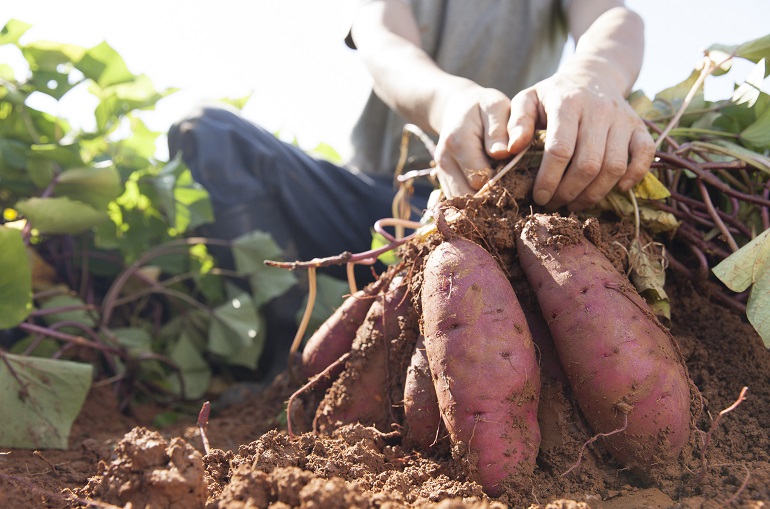How to Grow Sweet Potatoes in Your Backyard

This post is also available in:
This post is also available in:
![]() Español (Spanish)
Español (Spanish) ![]() Français (French)
Français (French) ![]() Deutsch (German)
Deutsch (German) ![]() हिन्दी (Hindi)
हिन्दी (Hindi) ![]() Ελληνικά (Greek)
Ελληνικά (Greek)
Growing sweet potatoes in a pot
More and more people like to grow their own fruits and vegetables as a hobby, for self-satisfaction, and to control what they eat. However, growing fruits and vegetables in your backyard may turn risky. Thus, there are some things you certainly need to avoid.
Things to consider when growing Sweet potatoes:
- Sweet potatoes are tropical crops. They need temperatures from 21 °C to 29 °C (69.8 °F – 84.2 °F) and plenty of sunlight to thrive. They can tolerate temperatures close to 12 °C (53.6 °F) without dying, but only for short periods. However, we start to observe fruit-setting problems when day temperatures stay under 12 °C (53.6 °F) for long periods.
- People usually grow Sweet potatoes from slips. If you already have sweet potatoes at home, consider starting to grow the slips.
- You shall first select a healthy un-craked potato as a mother slip producer. A commonly used technique is to bury the potatoes under moist sand for about 1-2 months until they have developed a sufficient number of sprouts. Once they have developed 20-25 cm (8-10 inches) sprouts and many leaves, consider removing them from the mother root and transplanting them into their final positions. Some backyard growers may also prefer to sink the potato in water containers up to half or keep them in sunny areas in temperatures between 18-21 °C (65-70 °F)
- If you want to avoid slip production, you can buy your plants from a legitimate seller and transplant them into their final positions in the garden. Remember that sweet potato transplanting will probably not be successful in temperatures lower than 20 °C or 68 °F.
- You can plant your sweet potatoes in pots or directly in the soil. Keep in mind that sweet potatoes grown in a pot will probably be small and fewer in number because of the lack of growth space.
- In case you are going to plant them directly in the soil, consider creating hills of 40 cm (16 inches in height), keeping distances 30-45 cm (12 to 18 inches) between plants.
- Sweet potatoes are generally considered drought-tolerant plants. However, they respond positively to irrigation. Depending on the soil and weather conditions, the plant needs watering once a week. Make sure you provide your plants with consistent water amounts to avoid stress. Keep in mind that excess water during the early stages may delay root growth. On the other hand, excess water during maturity stages may lead to cracked and rotten potatoes.
- When it comes to backyard cultivation, many growers prefer to apply well-rotted manure or compost as fertilization methods during the growing period to increase mainly Nitrogen and Potassium in the soil.
- Sweet potatoes mature and can be harvested 20 to 22 weeks after transplanting. After years of practice, commercial growers collect 10-30 tonnes per hectare. Of course, the yields depend on the variety and environmental conditions. If all things go well, you may be able to harvest up to 15 healthy, well-shaped sweet potatoes from each plant.
http://extension.msstate.edu/publications/growing-sweet-potatoes-home
Sweet Potato cultivation guide:
Fast Facts about Sweet Potatoes
Sweet Potato Plant Information and Variety Selection
Sweet Potato Nutrition and Health Benefits
How to Grow Sweet Potatoes in Your Backyard
How to Grow Sweet Potatoes for Profit
How to Produce Sweet Potato Slips
Sweet Potato Soil Requirements, Soil Preparation, and Planting
Sweet Potato Water Requirements and Irrigation Systems
Sweet Potato Fertilization Requirements
Sweet Potato Major Pests, Diseases and Weed Control









































































